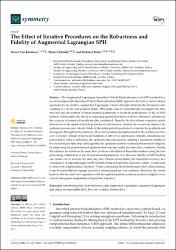The Effect of Iterative Procedures on the Robustness and Fidelity of Augmented Lagrangian SPH
Abstract
The Augmented Lagrangian Smoothed Particle Hydrodynamics (ALSPH) method is a novel incompressible Smoothed Particle Hydrodynamics (SPH) approach that solves Navier-Stokes equations by an iterative augmented Lagrangian scheme through enforcing the divergence-free coupling of velocity and pressure fields. This study aims to systematically investigate the time step size and the number of inner iteration parameters to boost the performance of the ALSPH method. Additionally, the effects of computing spatial derivatives with two alternative schemes on the accuracy of numerical results are also scrutinized. Namely, the first scheme computes spatial derivatives on the updated particle positions at each iteration, whereas the second one employs the updated pressure and velocity fields on the initial particle positions to compute the gradients and divergences throughout the iterations. These two schemes are implemented to the solution of a flow over a circular cylinder at Reynolds numbers of 200 in two dimensions. Initially, simulations are performed in order to determine the optimum time step sizes by utilizing a maximum number of five iterations per time step. Subsequently, the optimum number of inner iterations is investigated by employing the predetermined optimum time step size under the same flow conditions. Finally, the schemes are tested on the same flow problem with different Reynolds numbers using the best performing combination of the aforementioned parameters. It is observed that the ALSPH method can enable one to increase the time step size without deteriorating the numerical accuracy as a consequence of imposing larger ALSPH penalty terms in larger time step sizes, which, overall, leads to improved computational efficiency. When considering the hydrodynamic flow characteristics, it can be stated that two spatial derivative schemes perform very similarly. However, the results indicate that the derivative operation with the updated particle positions produces slightly lower velocity divergence magnitudes at larger time step sizes.

















